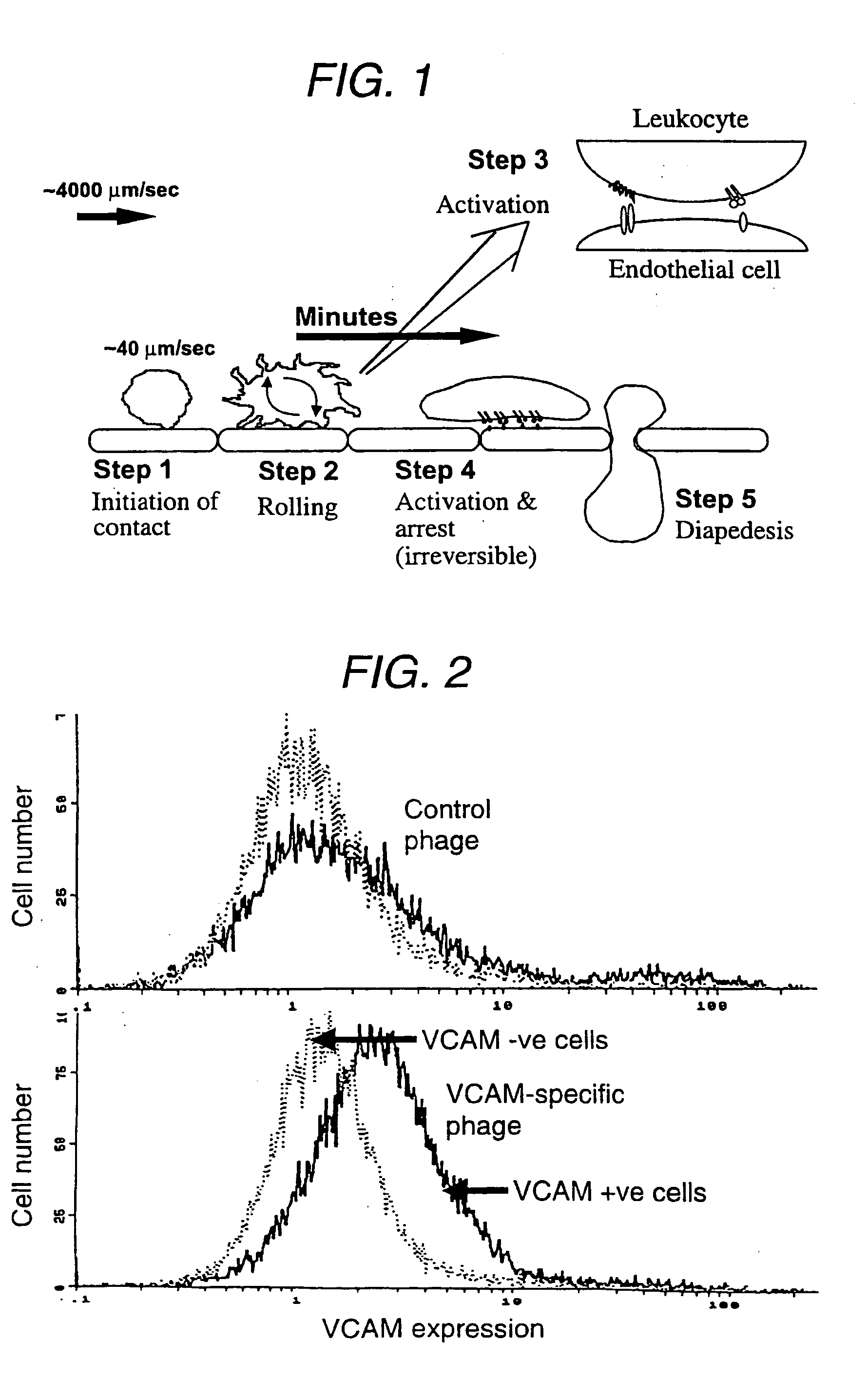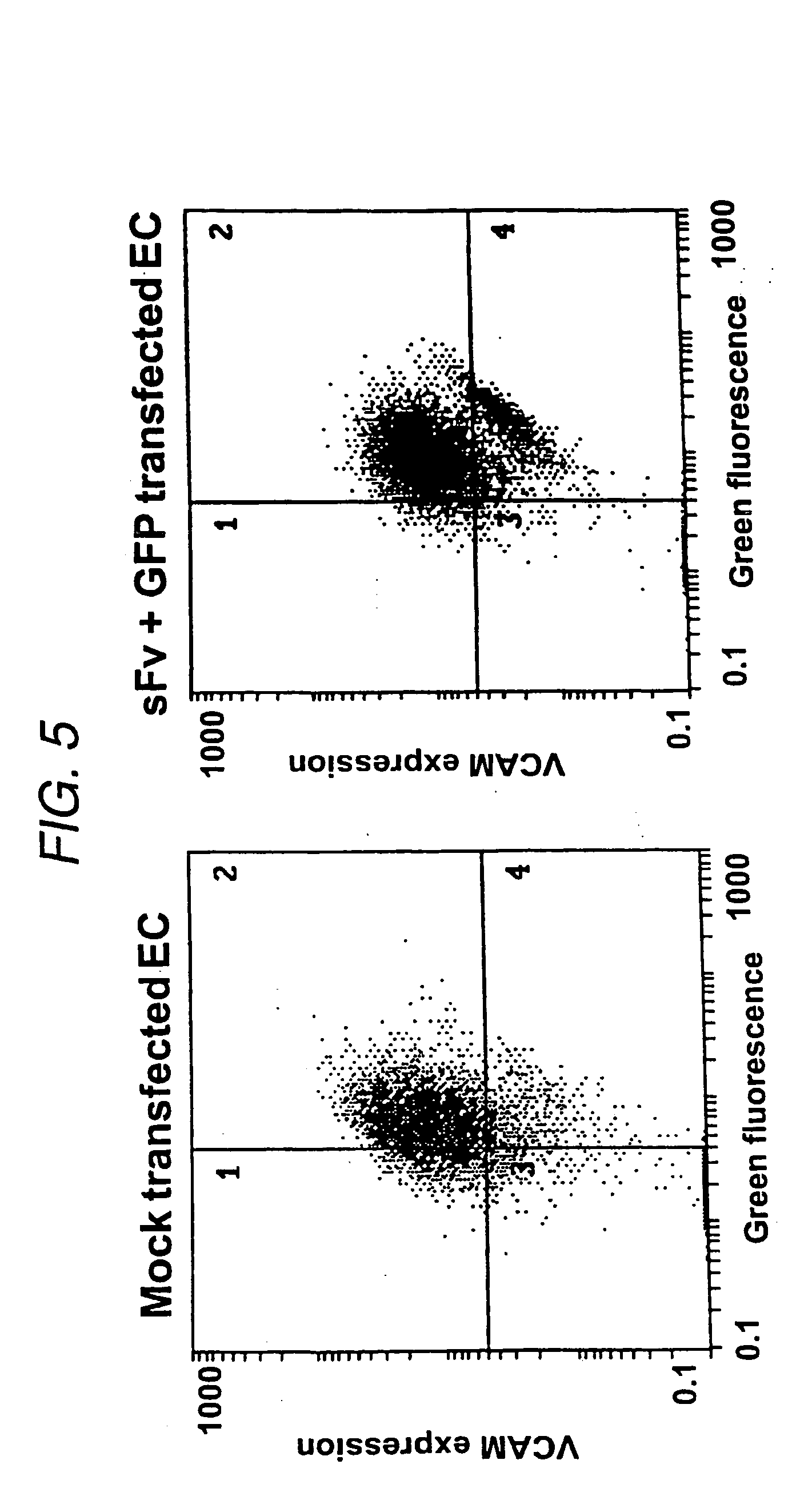Suppression of xenotransplant rejection
a technology for xenografts and transplants, applied in the field of xenograft rejection suppression, can solve the problems of xenogeneic organ rapid rejection, poor knockout effect, and many patients with little or no chance of receiving transplanted organs, etc., and achieve the effect of improving the efficiency of knockou
- Summary
- Abstract
- Description
- Claims
- Application Information
AI Technical Summary
Benefits of technology
Problems solved by technology
Method used
Image
Examples
example 1
Identification of VCAM-Specific sFv from a Phage-Display Library
[0075] A phage-display antibody library was used to generate an sFv specific for VCAM-1. The library used contains >108 clones generated using a bank of 50 cloned human VH gene segments with a random nucleotide sequence encoding CDR3 lengths of 4-12 residues (Richardson et al., 1993). This library has already been used to isolate specific single-chain antibodies to a variety of antigens including haptens, foreign and self antigens. However selection has depended upon the availability of purified or recombinant antigen. We developed a novel screening strategy to overcome the lack of recombinant porcine VCAM.
[0076] cDNA for porcine VCAM was used to generate stable cell lines that exhibit high levels of surface porcine VCAM expression as assessed by flow cytometry. VCAM positive cells were incubated with 3 μM CellTracker™ Green CMFDA (5-chloromethylfluorescein diacetate, (Molecular Probes, Oregon) for 1 hour at 37° C. On...
example 2
Subcloning of sFv for Targeted Intracellular Expression
[0079] Our strategy was to engineer the VCAM-specific sFv to be retained within the ER, so that providing that the sFv-VCAM interaction was of sufficient affinity, both molecules would be retained within the ER and degraded, thereby reducing cell-surface VCAM levels. Initially, the sFv has been expressed using a constitutively active promoter, the promoter from the human elongation factor 1α-subunit (EF-1α).
[0080] The sFv was amplified from the phagemid vector by PCR (30 cycles, annealing temperature 55° C., 1.5 μM Mg2+) using the primers:
(5′)CAGTCTATGCGGCCCCATTCA(3′);and(5′)TCCACAGGCGCGCACTCCCAGCCGGGCATGGCCCAGGT(3′).
[0081] The resulting fragment was subcloned into BssHII / Notl sites in pEF / myc / ER (Invitrogen, BV). The sFv was directed to the ER by incorporation of the sequence of a signal peptide from a mouse VH chain at the 5′-end of the sFv gene; this peptide is cleaved upon translocation into the ER. The sFv is retained b...
example 3
Effect of sFv Constructs on VCAM Expression
Co-Transfection of sFv / ER with pEF / GFP / ER
[0082] Functional analysis of the constructs was carried out by transfection into an immortalized porcine endothelial cell line A9. These were generated by microinjection of pZipSVU19 DNA into primary aortic endothelial cells (Dorling et al., 1996). The immortalized cells retain the characteristics of endothelial cells but unlike primary ECs, demonstrated constitutive expression of VCAM. Cytokine treatment of the cells increased VCAM expression marginally (RMFI increase from 38.2 to 66.3 at 72 hours).
[0083] Transfection of DNA was carried out with the liposome formulation LipofectAMINE (Life Technologies) using a modification of the manufacturer's protocol. LipofectAMINE reagent is a 3:1 (w / w) formulation of the polycationic lipid 2,3-dioleyloxy-N-[2(sperminecarboxamido)ethyl]-N,N-dimethyl-1-propanaminium trifluoroacetate (DOSPA) and the neutral lipid dioleoyl phosphatidtlethanolamine (DOPE) in w...
PUM
| Property | Measurement | Unit |
|---|---|---|
| temperature | aaaaa | aaaaa |
| volume | aaaaa | aaaaa |
| final volume | aaaaa | aaaaa |
Abstract
Description
Claims
Application Information
 Login to view more
Login to view more - R&D Engineer
- R&D Manager
- IP Professional
- Industry Leading Data Capabilities
- Powerful AI technology
- Patent DNA Extraction
Browse by: Latest US Patents, China's latest patents, Technical Efficacy Thesaurus, Application Domain, Technology Topic.
© 2024 PatSnap. All rights reserved.Legal|Privacy policy|Modern Slavery Act Transparency Statement|Sitemap



